Headline and core inflation remained at elevated levels in many economies during the first half of 2006-07 reflecting high commodity prices and strong demand conditions. Although headline inflation eased somewhat from August 2006 levels in tandem with the softening of international crude oil prices and favourable base effects, it remains above the inflation targets/comfort zones in many economies. Many central banks continued with pre-emptive monetary tightening to mitigate the second round effects, especially in the face of continuing strong demand. Amongst advanced economies, the European Central Bank (ECB), the Bank of England, the Reserve Bank of Australia and the Bank of Japan raised their policy rates during 2006-07. The US Fed, however, has left its rate unchanged since end-June 2006 in view of some slowing down of economic activity. Amongst emerging economies, central banks such as the South African Reserve Bank, the People's Bank of China, the Bank of Korea and the Central Bank of the Republic of Turkey raised their policy rates during 2006-07. Central banks in emerging market economies such as Korea, China and Russia also raised cash reserve requirements to address concerns regarding excess liquidity arising, particularly from large external flows. Some other central banks such as the Bank of Thailand and the Bank of Israel changed direction over the course of the year - raising rates initially and then cutting them to support growth.
In India, prices of primary food articles and manufactured products exerted upward pressures on headline inflation in 2006-07. Wholesale price inflation was generally within the Reserve Bank's indicative projections of 5.0-5.5 per cent up to mid-November 2006 and rose above the upper end of the band thereafter. The year-on-year (y-o-y) inflation was 5.7 per cent as on March 31, 2007 as compared with 4.0 per cent a year ago. Measures of consumer price inflation remained above the WPI inflation throughout the year, mainly reflecting the impact of higher food prices. The Reserve Bank continued with the policy of gradual withdrawal of monetary accommodation, using various instruments at its disposal flexibly to stabilise inflationary expectations, while continuing to pursue the medium term goal of a ceiling on inflation at 5.0 per cent. The Government also took fiscal and supply-side measures to contain inflation.
Global Inflation
Headline inflation in major advanced economies remained firm till August 2006 in tandem with crude oil prices reaching record highs. It eased during September-October 2006 on the back of base effects as well as the sharp decline in international crude oil prices but again rose during December 2006-March 2007 (Chart 21). Consumer price inflation in the OECD countries rose from 2.5 per cent
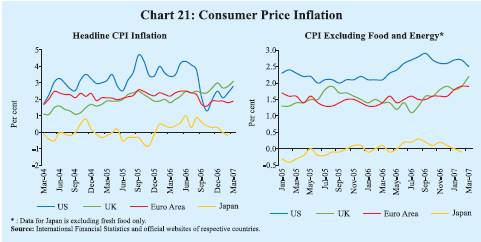
in March 2006 to a peak of 3.1 per cent in June 2006 before moderating to 2.1 per cent in February 2007. Amongst major economies, headline inflation in the US rose from 3.4 per cent in March 2006 to 4.3 per cent in June 2006. Although it has since moderated to 2.8 per cent in March 2007, it remains at elevated levels. In the UK, CPI inflation increased to 3.1 per cent in March 2007 from 1.8 per cent a year ago. In the euro area, inflation remained above the target of 'below but close to 2.0 per cent' till August 2006, and moderated thereafter to 1.9 per cent in March 2007. Notwithstanding some moderation in headline inflation, core inflation still remains firm in major economies. CPI inflation (excluding food and energy) was 2.5 per cent in the US in March 2007 (2.1 per cent a year ago) and 2.1 per cent in the OECD countries in February 2007 (1.6 per cent a year ago). Many central banks have, therefore, continued to tighten monetary policies in order to contain inflation and inflationary expectations, especially in view of continued strength of demand and possible stronger pass-through of past increases in oil prices. After having raised its target federal funds rate by 425 basis points since the tightening began in June 2004, the US Fed has paused at each of the meetings held since end-June 2006 (Chart 22). Economic growth moderated in the second half of 2006, partly reflecting a cooling of the housing market. Core inflation remains at elevated level. The Federal Open Market Committee in its latest meeting held on March 21, 2007 noted that the risk that inflation will fail to moderate as expected remains the predominant policy concern. It indicated that future policy adjustments will depend on the evolution of the outlook for both inflation and economic growth, as implied by incoming information.
In the euro area, notwithstanding some easing in inflation since August 2006, risks to the price outlook are seen on the upside due to the possibility of 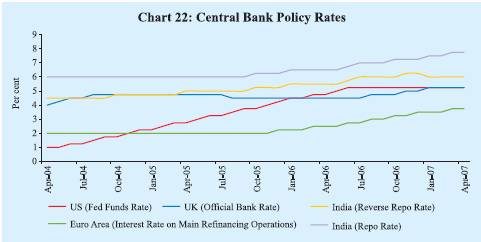
further oil price rises, additional increases in administered prices and indirect taxes and stronger than currently expected wage developments. The European Central Bank (ECB), therefore, raised the key policy rate by 25 basis points each on five occasions during 2006-07 (June 2006, August 2006, October 2006, December 2006 and March 2007). The policy rate has been increased by 175 basis points since the tightening began in December 2005 (Table 30). Given the favourable economic environment, the ECB is of the view that monetary policy continues to be on the accommodative side, with the key interest rates moderate, money and credit growth vigorous, and liquidity in the euro area ample by all plausible measures.
In view of strong economic activity, limited spare capacity, rapid growth of broad money and credit, rise in asset prices and expectations about inflation remaining above the target in the near term, the Bank of England raised its policy rate by 25 basis points each in August 2006, November 2006 and January 2007 to 5.25 per cent. The Bank of Japan (BoJ), after maintaining zero interest rates for an extended period, raised the uncollateralised overnight call rate (the operating target of monetary policy since March 2006) by 25 basis points each on two occasions - July 2006 and February 2007 - during the year to 0.50 per cent. The BoJ believes that monetary environment still remains very accommodative. With regard to the future course of monetary policy, the Bank of Japan has stated that it will adjust the level of interest rates gradually in the light of developments in economic activity and prices, while maintaining the accommodative financial conditions ensuing from very low interest rates for some time. Amongst other major advanced economies, central banks in Australia, Norway and New Zealand raised their policy rates during 2006-07.
Table 30: Global Inflation Indicators |
(Per cent) |
Country/ Region |
Key Policy Rate |
Policy Rates
(As on April 18, 2007) |
Changes in Policy Rates
(basis points) |
CPI Inflation
(y-o-y) |
Growth
(y-o-y) |
Since end- March 2005 |
Since end- March2006 |
2006
(Mar.) |
2007
(Mar.) |
2005
(Q4) |
2006
(Q4) |
1 |
2 |
3 |
4 |
5 |
6 |
7 |
8 |
9 |
Developed Economies |
|
|
|
|
|
|
|
Australia |
Cash Rate |
6.25 (Nov. 8, 2006) |
75 |
75 |
2.8 |
3.3 $ |
2.7 |
2.8 |
Canada |
Overnight Rate |
4.25 (May 24, 2006) |
175 |
50 |
2.2 |
2.0 * |
2.9 |
2.3 |
Euro area |
Interest Rate on |
|
|
|
|
|
|
|
|
Main Refinancing |
|
|
|
|
|
|
|
|
Operations |
3.75 (Mar. 8, 2007) |
175 |
125 |
2.2 |
1.9 |
1.7 |
3.3 |
Japan |
Uncollateralised |
|
|
|
|
|
|
|
|
Overnight Call Rate |
0.50 (Feb. 21, 2007) |
** |
50 |
-0.1 |
-0.2 * |
4.0 |
2.3 |
UK |
Official Bank Rate |
5.25 (Jan. 11, 2007) |
50 |
75 |
1.8 |
3.1 |
1.8 |
3.0 |
US |
Federal Funds Rate |
5.25 (June 29, 2006) |
250 |
50 |
3.4 |
2.8 |
3.2 |
3.1 |
Developing Economies |
Brazil |
Selic Rate |
12.50 (Apr. 18, 2007) |
(-)675 |
(-)400 |
5.3 |
3.0 |
1.4 |
3.8 |
India |
Reverse Repo Rate |
6.00 (July 25, 2006) |
125 |
50 |
4.9 |
7.6 * |
9.3 |
8.6 |
|
Repo Rate |
7.75 (Mar. 30, 2007) |
175 |
150 |
|
|
|
|
|
|
|
(150) |
(150) |
|
|
|
|
China |
Benchmark 1-year |
6.39 (Mar. 18, 2007) |
81 |
81 |
0.8 |
3.3 |
10.4 |
11.1 £ |
|
Lending Rate |
|
(300) |
(300) |
|
|
|
|
Indonesia |
BI Rate |
9.00 (Mar. 6, 2007) |
50 @ |
(-)375 |
15.8 |
6.5 |
4.9 |
6.1 |
Israel |
Key Rate |
4.00 (Feb. 26, 2007) |
50 |
(-)75 |
3.1 |
0.8 * |
4.8 |
3.7 |
Korea |
Overnight Call Rate |
4.50 (Aug. 10, 2006) |
125 |
50 |
2.0 |
2.2 |
5.3 |
4.0 |
|
|
|
(80) |
(80) |
|
|
|
|
Philippines |
Reverse Repo Rate |
7.50 (Oct. 20, 2005) |
75 |
0 |
7.6 |
2.2 |
6.1 |
6.5 |
Russia |
Refinancing Rate |
10.50 (Jan. 29, 2007) |
-250 |
-150 |
10.6 |
7.1 |
7.0 |
7.7 |
|
|
|
(150) |
(150) |
|
|
|
|
South Africa |
Repo Rate |
9.00 (Dec. 8, 2006) |
150 |
200 |
3.9 |
5.7 * |
4.5 |
6.1 |
Thailand |
14-day Repurchase Rate |
5.00 (June 7, 2006) |
275 |
50 |
5.7 |
2.0 |
4.7 |
4.2 |
|
1-day Repurchase Rate |
4.00 (Apr. 11, 2007) |
– |
(-)94^ |
|
|
|
|
@: Change since July 2005 when Bank Indonesia adopted BI rate as the reference rate with the
formal adoption of inflation targeting.
*: February 2007. $ : Q4 of 2006. £ : Q1 of 2007.
**: The Bank of Japan decided on March 9, 2006 to change the operating target of money market operations from the outstanding balance of current accounts at the Bank to the uncollateralised overnight call rate.
^: Change over January 16, 2007. Effective January 17, 2007, the 1-day repurchase rate replaced the 14-day repurchase rate as the policy rate.
Note :
1. For India, data on inflation pertain to CPI for Industrial Workers.
2. Figures in parentheses in column (3) give the date when the policy rates were last revised.
3. Figures in parentheses in columns (4) and (5) give the variation in cash reserve ratios during the period.
Source: International Monetary Fund, websites of respective central banks and the Economist. |
Inflation remains relatively modest in several economies in Asia, reflecting both pre-emptive monetary tightening as well as appreciation of the exchange rates. Consumer price inflation in China increased to 3.3 per cent in March 2007 from 0.8 per cent a year ago, partly on the back of higher food prices (Chart 23). Real GDP growth accelerated to 10.7 per cent in 2006 from 10.4 per cent in the previous year. Growth in fixed investment decelerated in 2006, but still remains 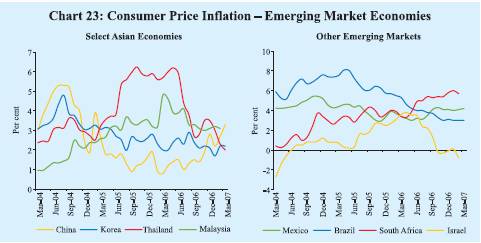
large. The economic activity has remained buoyant in 2007 so far. Real GDP growth accelerated to 11.1 per cent during the first quarter of 2007 from 10.4 per cent a year ago. Owing to persistent BOP surplus, excess liquidity has built up in the banking sector, and loan expansion remains fairly large. In view of strong growth in money supply and credit, the People's Bank of China (PBC) increased the benchmark 1-year lending rate by 27 basis points each in April 2006, August 2006 and March 2007. Apart from continued issuances of its own bills to mop up liquidity, the PBC has also raised the cash reserve ratio by 300 basis points since July 2006 in six steps (50 basis points each effective July 5, 2006, August 15, 2006, November 15, 2006, January 15, 2007, February 25, 2007 and April 16, 2007) to 10.50 per cent. The monetary measures were supported by a series of industrial structure adjustments and trade policies - such as terminating/lowering the export tax rebate for non-ferrous metals and scraps - to curb the export of high energy-consuming and high-polluting sectors and resources. In response to a sharp rise in foreign investment in the real estate sector and the purchase of housing by overseas institutions and individuals, measures were taken by the authorities in July 2006 to regulate foreign investment in China's real estate market.
In Korea, real GDP growth moderated to 4.0 per cent in the quarter ended December 2006 from 5.3 per cent a year ago. Consumer price inflation and core inflation both remain stable. The Bank of Korea has, therefore, kept its policy rate unchanged at 4.5 per cent since August 2006 (after having raised the rates by 125 basis points since the tightening began in October 2005). However, in view of sharp growth in monetary and credit aggregates, and financial institutions' liquidity, led by inflows of foreign funds, the Bank of Korea increased the cash reserve ratio on demand deposits and money market deposit accounts from 5.0 per cent to 7.0 per cent, effective December 23, 2006. The reserve requirement on time deposits, various instalment deposits and certificates of deposits was kept unchanged at 2.0 per cent, while long-term time and savings deposits were exempted from the existing 1.0 per cent requirement. Following this adjustment, the average reserve requirement ratio rose from 3.0 per cent to 3.8 per cent. In response to these measures, the Bank of Korea expects that the pace of liquidity expansion will slow and the short-term bias of financial institutions' deposit structures will lessen.
In Thailand, real GDP growth was 4.2 per cent in the quarter ended December 2006 as compared with 4.7 per cent a year ago. In the first quarter of 2007, domestic demand slowed down led by private consumption and investment. Inflationary pressures are expected to moderate. Therefore, the Bank of Thailand has since January 17, 2007 lowered the 1-day repurchase rate (which replaced the 14-day repurchase rate as the policy rate) by 94 basis points to 4.00 per cent on April 11, 2007. The Bank of Thailand had earlier raised the policy rate by 275 basis points between June 2005 and June 2006. In order to discourage speculative short-term capital flows and to help maintain stability in the Thai baht with the objective of sustaining long-run growth in the Thai economy, the Bank of Thailand (BoT) on December 18, 2006 decided to impose unremunerated reserve requirement (URR) of 30 per cent on short-term capital flows. However, on December 19, 2006, the BoT exempted investments in stock markets from the URR.
In Indonesia, economic activity gradually regained momentum during 2006, driven primarily by rapidly expanding exports and also by domestic consumption. Inflation, which had reached 18.4 per cent in November 2005, eased sharply to 6.5 per cent in March 2007 reflecting monetary policy actions as well as the easing of oil prices and the base effect. Bank Indonesia has, therefore, cut its policy rate by 375 basis points since May 2006 to 9.00 per cent in March 2007 to support growth. The policy rate was earlier raised by 425 basis points during July-December 2005 to contain inflation.
Amongst other emerging economies, the South African Reserve Bank raised the policy rate by 200 basis points - 50 basis points each in June, August, October and December 2006 - to 9.0 per cent to contain inflationary pressures emanating from volatility in oil prices and from food and services prices. Turkey has kept rates unchanged since August 2006 on the back of slowdown in domestic demand and moderation in inflation expectations. Turkey had earlier increased its policy rate by 425 basis points during June-July 2006 on concerns over the possible pass-through effect of the exchange rate movements arising from the volatility in international financial markets. On the other hand, in view of weak economic activity, Brazil has reduced policy rates by 725 basis points since September 2005 to 12.50 per cent on April 18, 2007. The Bank of Israel has cut its policy rate by 150 basis points since October 2006 (25 basis points each in October and November 2006, 50 basis points in December 2006, 25 basis points each in January 2007 and February 2007) to 4.00 per cent to support growth, after having raised rates by 200 basis points between September 2005 and August 2006. In Russia, consumer price inflation remains high, although it eased somewhat to 7.1 per cent in March 2007 from 10.6 per cent a year ago. Money supply (M2) growth accelerated to 50.4 per cent, year-on-year, as on March 1, 2007 from 37.3 per cent a year ago. The Bank of Russia raised the required reserve ratio on credit institutions' liabilities to non-resident banks in rubles and foreign currency from 2.0 per cent to 3.5 per cent on October 31, 2006. It has, however, reduced the refinancing rate by 150 basis points - 50 basis points each on three occasions - from 12.0 per cent in December 2005 to 10.5 per cent in January 2007.
Global Commodity Prices
Non-fuel commodity prices firmed up during 2006-07 led by metals and food prices. Crude oil prices rose sharply in the first four months of 2006-07 to reach a record high but witnessed a sharp correction thereafter; on a year-on-year basis, prices were broadly unchanged in March 2007. Metals prices recorded large gains, especially during April 2006 up to mid-May 2006, on the back of robust demand in emerging economies, especially China. Food prices, led by wheat and edible oil, rose reflecting a shortfall in global production (Chart 24).
International crude oil prices (WTI) exhibited large intra-year volatility during 2006-07. Prices initially firmed up to reach a record high of US $ 78.4 a barrel on July 14, 2006 on concerns over Iran's nuclear programme and unrest in Nigeria, amidst limited spare capacity. Subsequently, prices eased to below US $ 60 a barrel during October-November 2006 on the back of signs of slowdown of the US economy, increased US stocks and easing of tension over Iran's nuclear programme (Table 31, Table 32). Prices edged up to around US $ 62-63 a barrel in December 2006 on 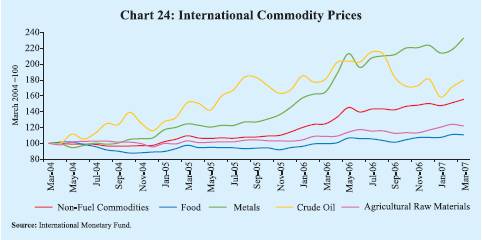
Table 31: International Crude Oil Prices |
(US dollars per barrel) |
Year/Month |
Dubai Crude |
UK Brent |
US WTI |
Average Crude Price |
Indian Basket Price |
1 |
2 |
3 |
4 |
5 |
6 |
2001-02 |
21.8 |
23.2 |
24.1 |
23.0 |
22.4 |
2002-03 |
25.9 |
27.6 |
29.2 |
27.6 |
26.6 |
2003-04 |
26.9 |
29.0 |
31.4 |
29.1 |
27.8 |
2004-05 |
36.4 |
42.2 |
45.0 |
41.3 |
38.9 |
2005-06 |
53.4 |
58.0 |
59.9 |
57.1 |
55.4 |
2006-07 |
60.9 |
64.4 |
64.7 |
63.3 |
62.4 |
March 2004 |
30.5 |
33.8 |
36.7 |
33.7 |
31.9 |
March 2005 |
45.6 |
53.1 |
54.2 |
50.9 |
48.8 |
March 2006 |
57.7 |
62.3 |
62.9 |
60.9 |
59.6 |
April 2006 |
64.1 |
70.4 |
69.5 |
68.0 |
66.8 |
May 2006 |
64.9 |
70.2 |
70.9 |
68.6 |
67.2 |
June 2006 |
65.1 |
68.9 |
70.9 |
68.3 |
66.7 |
July 2006 |
69.1 |
73.9 |
74.4 |
72.5 |
71.1 |
August 2006 |
68.8 |
73.6 |
73.0 |
71.8 |
70.9 |
September 2006 |
59.8 |
62.8 |
63.8 |
62.0 |
61.1 |
October 2006 |
56.5 |
58.4 |
58.9 |
58.0 |
57.3 |
November 2006 |
56.8 |
58.5 |
59.1 |
58.1 |
57.5 |
December 2006 |
58.7 |
62.3 |
62.0 |
61.0 |
60.2 |
January 2007 |
52.0 |
54.3 |
54.2 |
53.5 |
53.0 |
February 2007 |
55.7 |
57.8 |
59.3 |
57.6 |
56.6 |
March 2007 |
59.1 |
62.1 |
60.6 |
60.6 |
60.4 |
Source : International Monetary Fund and the World Bank. |
the back of fall in US product inventories and production cuts by the Organisation of the Petroleum Exporting Countries (OPEC). The OPEC reduced crude oil production by 1.2 million barrels per day (mb/d) effective November 1, 2006 to balance supply and demand to support prices. Nonetheless, prices eased further to US $ 51 a barrel in January 2007 mainly on account of mild winter in the US and rise in the US stocks. Prices, however, rebounded in the last week of January 2007 and reached US $ 60 a barrel in February 2007 on the back of renewed winter demand and the second production cut of 0.5 mb/d by OPEC, effective February 1, 2007. Prices rose further to around US $ 67 in late March 2007 on tensions over Iran's detention of British naval personnel. Prices eased to US $ 64 a barrel by April 5, 2007 on the release of the British naval personnel.
Metals prices remained firm during 2006-07 on the back of robust demand and supply constraints amidst speculative investor interest. After witnessing a steady rise since late 2004 and, in particular, sharp rise during April 2006 and early May 2006, global metal prices witnessed sharp correction in mid-May 2006 on fears that further tightening by the US might slow down demand for metals. Prices have since then been largely range-bound, with intermittent episodes of corrections reflecting incoming information on global growth prospects. Some metals such as lead, nickel and tin registered large gains during 2006-07. Prices of aluminium, copper, tin and zinc during March 2007 were higher by about 14
Table 32: World Supply-Demand Balance of Oil |
(Million barrels per day) |
Item |
2003 |
2004 |
2005 |
2006 |
2007
(P) |
2008
(P) |
2007 P |
Q1 |
Q2 |
Q3 |
Q4 |
1 |
2 |
3 |
4 |
5 |
6 |
7 |
8 |
9 |
10 |
11 |
Demand |
1. |
OECD |
48.7 |
49.5 |
49.6 |
49.1 |
49.6 |
49.9 |
50.4 |
48.2 |
49.3 |
50.5 |
2. |
Non-OECD |
31.2 |
33.0 |
34.4 |
35.4 |
36.5 |
37.8 |
35.9 |
36.0 |
36.5 |
37.5 |
|
of which: China |
5.6 |
6.5 |
6.9 |
7.3 |
7.7 |
8.2 |
7.4 |
7.7 |
7.7 |
8.0 |
3. |
Total (1+2) |
79.9 |
82.5 |
84.0 |
84.6 |
86.1 |
87.7 |
86.3 |
84.2 |
85.8 |
88.0 |
Supply |
4. |
Non-OPEC |
48.9 |
50.1 |
50.3 |
49.3 |
50.0 |
50.8 |
49.6 |
49.7 |
50.1 |
50.5 |
5. |
OPEC |
30.7 |
32.9 |
34.2 |
35.2 |
35.4 |
36.9 |
34.6 |
34.9 |
36.0 |
36.2 |
6. |
Total (4+5) |
79.6 |
83.1 |
84.5 |
84.5 |
85.4 |
87.6 |
84.2 |
84.6 |
86.1 |
86.7 |
Stock Changes |
0.3 |
-0.6 |
-0.5 |
0.1 |
0.7 |
0.0 |
2.1 |
-0.3 |
-0.4 |
1.2 |
P: Projections.
Source : US Energy Information Administration. |
per cent, 26 per cent, 75 per cent and 35 per cent, respectively, over their levels a year ago while nickel prices nearly trebled. International steel prices declined during the year (Table 33).
Table 33: International Commodity Prices |
Commodity |
Unit |
2004 |
Index |
Variation
(per cent)
(Mar. 2007
over Mar.
2006) |
2004 |
2005 |
2006 |
2006-07 |
2007 March |
|
Apr.- Jun. |
Jul.- Sept. |
Oct.- Dec. |
Jan.- Mar. |
|
|
1 |
2 |
3 |
4 |
5 |
6 |
7 |
8 |
9 |
10 |
11 |
12 |
Energy |
Coal |
|
$/mt |
53.0 |
100.0 |
89.8 |
92.6 |
99.2 |
94.9 |
87.9 |
100.2 |
104.2 |
11.0 |
Crude oil (Average) |
|
$/bbl |
37.7 |
100.0 |
141.6 |
170.6 |
181.2 |
182.5 |
156.5 |
151.7 |
160.7 |
-0.5 |
Non-Energy Commodities |
|
|
|
|
|
|
|
|
|
|
|
Palm oil |
|
$/mt |
471.3 |
100.0 |
89.6 |
101.5 |
93.1 |
104.5 |
115.8 |
129.2 |
132.0 |
41.4 |
Soybean oil |
|
$/mt |
616.0 |
100.0 |
88.5 |
97.2 |
93.6 |
100.7 |
107.5 |
115.2 |
116.6 |
33.2 |
Soybeans |
|
$/mt |
306.5 |
100.0 |
89.6 |
87.6 |
86.0 |
86.1 |
94.6 |
103.7 |
105.1 |
25.8 |
Rice |
|
$/mt |
237.7 |
100.0 |
120.4 |
128.3 |
129.4 |
131.4 |
126.5 |
133.3 |
135.7 |
6.3 |
Wheat |
|
$/mt |
156.9 |
100.0 |
97.1 |
122.4 |
120.8 |
125.0 |
133.0 |
126.4 |
126.9 |
14.2 |
Sugar |
|
c/kg |
15.8 |
100.0 |
138.0 |
206.3 |
231.0 |
193.7 |
162.7 |
148.7 |
145.6 |
-39.7 |
Cotton A Index |
|
c/kg |
136.6 |
100.0 |
89.1 |
92.8 |
89.2 |
93.7 |
93.6 |
94.4 |
94.4 |
-0.3 |
Aluminium |
|
$/mt |
1716.0 |
100.0 |
110.6 |
149.8 |
154.6 |
144.6 |
158.7 |
163.2 |
161.0 |
13.7 |
Copper |
|
$/mt |
2866.0 |
100.0 |
128.4 |
234.5 |
251.6 |
267.6 |
246.6 |
207.0 |
225.1 |
26.4 |
Gold |
|
$/toz |
409.2 |
100.0 |
108.7 |
147.7 |
153.3 |
151.9 |
150.2 |
158.9 |
160.0 |
17.6 |
Silver |
|
c/toz |
669.0 |
100.0 |
109.7 |
172.9 |
183.3 |
174.7 |
188.8 |
199.1 |
196.7 |
26.8 |
Steel cold-rolled coil/sheet |
$/mt |
607.1 |
100.0 |
120.8 |
114.3 |
109.8 |
115.3 |
108.4 |
107.1 |
107.1 |
-13.3 |
Steel hot-rolled coil/sheet |
$/mt |
502.5 |
100.0 |
126.0 |
119.4 |
117.8 |
119.4 |
111.1 |
109.5 |
109.5 |
-15.4 |
Tin |
|
c/kg |
851.3 |
100.0 |
86.7 |
103.1 |
100.2 |
101.6 |
121.4 |
149.5 |
163.2 |
75.0 |
Zinc |
|
c/kg |
104.8 |
100.0 |
131.8 |
312.5 |
314.1 |
320.9 |
401.1 |
329.8 |
312.1 |
35.3 |
$ : US dollar. c : US cent. bbl : barrel. mt : metric tonne. kg : Kilogram. toz: troy oz.
Source : Based on World Bank's actual commodity price data. The year 2004 has been taken as the base to better exhibit price trends over the relevant period. |
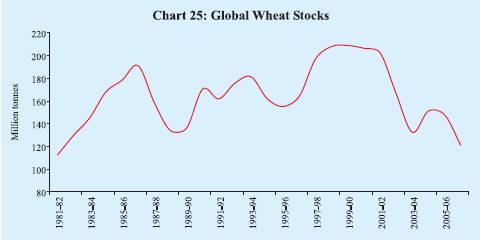
Food prices firmed up led by wheat and edible oils on reports of shortfalls in production and increased demand for non-food uses. According to the latest assessment by the Food and Agriculture Organisation (FAO)/US Department of Agriculture (USDA), global wheat production is expected to decline by 4.4 per cent in 2006-07 on the back of hot and dry weather/drought affecting crops in Australia, Argentina and Brazil. As a result, wheat stocks are expected to fall by about 18 per cent to 121 million tonnes by the end of 2006-07 season. At this level, the stocks of wheat will be the lowest since 1981-82 (112.5 million tonnes) (Chart 25). In view of these developments, wheat prices have firmed up since the second half of 2005. After some easing between November 2006 and January 2007, wheat prices again firmed up in February 2007. Prices in March 2007 were higher by about 14 per cent on a year-on-year basis (Chart 26). Rice production is also expected to decline during 2006-07, albeit marginally (by 0.4 per cent) resulting in a drawdown of stocks by 0.6 per cent. After showing signs of softness during October-November 2006, rice prices again firmed up from December 2006. Prices in March 2007 were higher by about 6 per cent on a year-on-year basis.
Prices of oilseeds and edible oils edged up sharply in the second half of 2006-07, inter alia, due to lower production coupled with strong demand for non-food uses such as fuels and as feedstock for bio-diesel production. On a year-on-year basis, soybean, soybean oil and palm oil prices in March 2007 were higher by 26 per cent, 33 per cent and 41 per cent, respectively.
International sugar prices, which had increased sharply in early 2006, eased significantly from August 2006 on forecasts of higher global production during 2006-07. Sugar prices have declined by almost 42 per cent by March
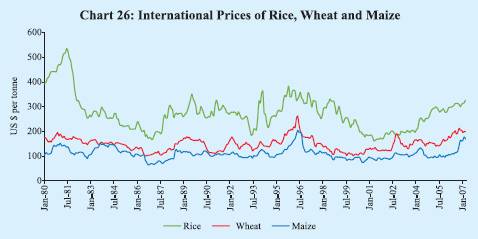
2007 from the recent peak touched in February 2006. According to the International Sugar Organisation, global sugar production is estimated to increase by 7.5 million tonnes to 160 million tonnes during 2006-07 (October-September) season, exceeding global consumption by 7.2 million tonnes. A record crop in Brazil, the world's largest producer, significant growth in output in the Far East along with likely higher production in India is expected to more than offset the contraction in the EU output. Global cotton prices were largely range-bound during 2006-07.
Futures markets suggest that international crude oil and food prices could firm up further in the coming months. Metals prices are expected to remain at around current levels in the near term but could ease over the next year (Table 34).
Table 34: International Commodity Prices – Futures Market |
Commodity |
Unit |
April/May 2007 |
July 2007 |
July 2008 |
1 |
2 |
3 |
4 |
5 |
Crude oil |
$/bbl |
63.1 |
65.7 |
69.8 |
Soybean oil |
cents/pound |
31.1 |
31.7 |
33.8* |
Soybeans |
cents/bushels |
715 |
732 |
791 |
Rice |
cents/cwt |
1,011 |
1,051 |
1,158# |
Wheat |
cents/bushels |
474 |
489 |
493 |
Aluminium |
$/mt |
2,836 |
2,880 |
2,703 |
Copper |
$/mt |
8,053 |
7,970 |
7,200 |
Tin |
c/kg |
14,400 |
14,200 |
13,325 |
Zinc |
c/kg |
3,685 |
3,698 |
3,378 |
# : March 2008. * : May 2008.
Source : Chicago Board of Trade, London Metals Exchange and NYMEX. |
Inflation Conditions in India
Monetary policy during 2006-07 was conducted to manage the transition to a higher growth path while ensuring that pressures on actual inflation and inflation expectations are contained. Taking into account the impact of real, monetary and global factors on domestic prices, the Reserve Bank in its Annual Policy Statement for 2006-07 (April 2006) noted that containing inflationary expectations would continue to pose a challenge to monetary management and the policy endeavour would be to contain the year-on-year inflation rate for 2006-07 in the range of 5.0-5.5 per cent. Against the backdrop of widespread and simultaneous monetary policy tightening by several countries in early June 2006 following marked and heightened volatility in the international financial markets, and in the light of the prevailing domestic monetary and credit environment, the LAF reverse repo and repo rates were increased by 25 basis points each to 5.75 per cent and 6.75 per cent, respectively, effective June 9, 2006. In its First Quarter Review of the Annual Statement on Monetary Policy (July 2006), the Reserve Bank observed that containing inflation in the range of 5.0-5.5 per cent warranted appropriate priority in policy responses. Accordingly, the Reserve Bank raised the reverse repo rate and the repo rate by 25 basis points each to 6.00 per cent and 7.00 per cent, respectively, on July 25, 2006. The Bank Rate and cash reserve ratio were left unchanged.
In the Mid-Term Review of Annual Policy Statement for 2006-07 (October 2006), it was observed that the combination of high growth and consumer inflation coupled with escalating asset prices and tightening infrastructural bottlenecks underscored the need to reckon with dangers of overheating and the implications for the timing and direction of monetary policy setting. The Mid-term Review further noted that although there was no conclusive evidence of potential overheating in the Indian economy at that time, the criticality of monitoring all available indications that could point to excess aggregate demand was perhaps more relevant. In the Mid-term Review, the repo rate was increased by 25 basis points to 7.25 per cent, while keeping the reverse repo rate unchanged at 6.00 per cent (Table 35).
In the Third Quarter Review (January 2007), the Reserve Bank observed that early warning signals emanating from rising inflation in an environment of high money and credit growth (
Chart 27) indicated that monetary policy was accommodative, warranting a policy response. Accordingly, the repo rate was increased by 25 basis points to 7.50 per cent while keeping the reverse repo rate unchanged at 6.0 per cent. It was also decided to reduce the interest rate ceilings on NR(E)RA and FCNR(B) deposits by 50 basis points and 25 basis points, respectively.
Table 35: Movement in Key Policy Rates and Inflation |
(Per cent) |
Effective since |
Reverse
Repo Rate |
Repo
Rate |
Cash
Reserve Ratio |
WPI
Inflation |
1 |
2 |
3 |
|
4 |
5 |
March 31, 2004 |
4.50 |
6.00 |
|
4.50 |
4.6 |
September 18, 2004 |
4.50 |
6.00 |
|
4.75 (+0.25) |
7.9 |
October 2, 2004 |
4.50 |
6.00 |
|
5.00 (+0.25) |
7.1 |
October 27, 2004 |
4.75 (+0.25) |
6.00 |
|
5.00 |
7.4 |
April 29, 2005 |
5.00 (+0.25) |
6.00 |
|
5.00 |
6.0 |
October 26, 2005 |
5.25 (+0.25) |
6.25 |
(+0.25) |
5.00 |
4.5 |
January 24, 2006 |
5.50 (+0.25) |
6.50 |
(+0.25) |
5.00 |
4.2 |
June 9, 2006 |
5.75 (+0.25) |
6.75 |
(+0.25) |
5.00 |
4.9 |
July 25, 2006 |
6.00 (+0.25) |
7.00 |
(+0.25) |
5.00 |
4.7 |
October 31, 2006 |
6.00 |
7.25 |
(+0.25) |
5.00 |
5.3 |
December 23, 2006 |
6.00 |
7.25 |
|
5.25 (+0.25) |
5.5 |
January 6, 2007 |
6.00 |
7.25 |
|
5.50 (+0.25) |
6.1 |
January 31, 2007 |
6.00 |
7.50 |
(+0.25) |
5.50 |
6.1 |
February 17, 2007 |
6.00 |
7.50 |
|
5.75 (+0.25) |
6.7 |
March 3, 2007 |
6.00 |
7.50 |
|
6.00 (+0.25) |
6.5 |
March 30, 2007 |
6.00 |
7.75 |
(+0.25) |
6.00 |
6.5 |
April 14, 2007 |
6.00 |
7.75 |
|
6.25 (+0.25)* |
|
* : As announced on March 30, 2007, CRR will be hiked by further 25 basis points effective
the fortnight beginning April 28, 2007.
Note :
1. With effect from October 29, 2004, the nomenclature of repo and reverse repo was changed
in keeping with international usage. Now, reverse repo indicates absorption of liquidity and
repo signifies injection of liquidity. Prior to October 29, 2004, repo indicated absorption of
liquidity while reverse repo meant injection of liquidity. The nomenclature in this Report is
based on the new usage of terms even for the period prior to October 29, 2004.
2. Figures in parentheses indicate change in policy rates. |
In order to reinforce the measures already taken for maintaining price stability and anchoring inflation expectations to sustain the growth momentum, 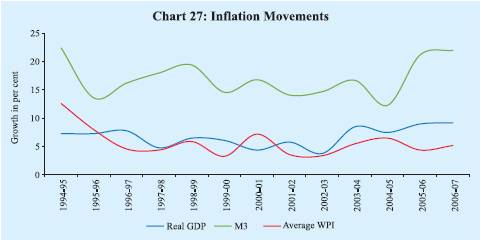
the Reserve Bank, on March 30, 2007 announced a further hike of 25 basis points in the repo rate to 7.75 per cent, while leaving the reverse repo rate unchanged. It also decided to increase the CRR by another 50 basis points in two stages of 25 basis points each effective April 14, 2007 and April 28, 2007 - a cumulative increase of 150 basis points from December 2006 (see Chapter III). The Reserve Bank emphasised that the conduct of monetary policy would continue to demonstrate that inflation beyond its tolerance threshold was unacceptable and that the resolve to ensure price stability was always backed by timely and appropriate policy responses.
An assessment of key macroeconomic indicators in select EMEs indicates that over the past year, consumer price inflation has eased in a number of economies such as Brazil, Indonesia, Israel, the Philippines, Russia and Thailand. It, however, rose in China, India and South Africa. Major EMEs, except India and South Africa, have recorded surplus in current accounts. Although the Centre's fiscal deficit in India declined during 2006-07, it remained higher than most EMEs. The real policy rate in India in March 2007 was marginally lower than a year ago and remained below that in major EMEs (Table 36).
Table 36: Key Macroeconomic Indicators: Emerging Markets |
(Per cent) |
Country |
Consumer Price Inflation |
Current Account
Balance
(per cent to GDP) |
Central Govt.
Fiscal Balance
(per cent of GDP) |
Real
Policy
Rate |
Real
GDP
Growth |
March
2006 |
March
2007 |
2005 |
2006 |
2005 |
2006 |
March
2006 |
March
2007 |
2005 |
2006 |
1 |
2 |
3 |
4 |
5 |
6 |
7 |
8 |
9 |
10 |
11 |
Brazil |
5.3 |
3.0 |
1.6 |
1.3 |
-3.4 |
-3.2 |
11.2 |
9.8 |
2.9 |
3.7 |
China |
0.8 |
3.3 |
7.2 |
9.1 |
-1.3 |
-0.7 |
4.8 |
3.1 |
10.4 |
10.7 |
India |
4.9 * |
7.6 * |
-1.2 @ |
– |
-4.1 @ |
-3.7 # |
1.6 |
0.2 |
9.0 @ |
9.2 # |
|
(4.1) |
(5.7) |
(-6.5) |
|
|
|
(2.4) |
(2.0) |
|
|
Indonesia |
15.8 |
6.5 |
0.1 |
2.7 |
-0.5 |
-1.0 |
-3.0 |
2.5 |
5.7 |
5.5 |
Israel |
3.1 * |
-0.8 * |
2.9 |
5.2 |
-2.9 |
-2.7 |
1.2 |
4.8 |
5.2 |
5.1 |
Korea |
2.0 |
2.2 |
1.9 |
0.7 |
1.9 |
1.8 |
2.0 |
2.3 |
4.2 |
5.0 |
Philippines |
7.6 |
2.2 |
2.0 |
2.9 |
-2.7 |
-1.0 |
-0.1 |
5.3 |
5.0 |
5.4 |
Russia |
10.6 |
7.1 |
10.9 |
9.8 |
7.5 |
7.5 |
1.4 |
3.4 |
6.4 |
6.7 |
South Africa |
3.9 * |
5.7 * |
-3.8 |
-6.4 |
– |
– |
3.6 |
3.3 |
5.1 |
5.0 |
Thailand |
5.7 |
2.0 |
-4.5 |
1.6 |
0.2 |
0.1 |
-1.2 |
2.5 |
4.5 |
5.0 |
* : February.
@ : Data pertain to fiscal year 2005-06.
# : Data pertain to fiscal year 2006-07.
Note :
1.As in Table 30, consumer price inflation data are on a year-on-year basis.
Data for India are for CPI-Industrial Workers.
2. Real policy rate is the policy rate less year-on-year consumer price inflation.
3. Figures in parentheses in columns (2) and (3) refer to wholesale price inflation.
4. Figures in parentheses in column (4) refer to trade balance/GDP ratio.
5. Figures in parentheses in columns (8) and (9) for India are based on wholesale price inflation.
6. Data on fiscal balance for Korea and Israel pertain to general government balance.
Source : IMF, ADB, official websites of respective central banks and the Economist. |
Wholesale Price Inflation
Inflation movements in 2006-07 were driven by primary food articles and manufactured products prices reflecting the impact of both supply side and demand side pressures. The impact of mineral oils, the major driver of inflation since June 2004, petered out by early September 2006 on the back of decline in domestic fuel prices and the base effect. Headline inflation, based on movement in the wholesale price index (WPI), increased to 5.7 per cent, y-o-y, as on March 31, 2007 from 4.0 per cent a year ago. WPI inflation moved in a range of 3.7-6.7 per cent during 2006-07 (Chart 28 and Table 37). Headline inflation remained within the Reserve Bank's indicative projection of 5.0-5.5 per cent up to November 11, 2006 (except one week) and crossed 6.0 per cent between January 6, 2007 and March 24, 2007. The average WPI inflation rate (average of the 52 weeks) during 2006-07 at 5.4 per cent was higher than that of 4.4 per cent a year ago. The y-o-y inflation, excluding the fuel group, at 7.1 per cent was above the headline inflation rate of 5.7 per cent as on March 31, 2007.
Among the major groups, prices of primary articles led by wheat, pulses, milk, oilseeds and raw cotton posed upward pressures on inflation during 2006-07 (Chart 29). Wheat prices remained firm on the back of low stocks and firm international prices. Domestic wheat stocks were 5.4 million tonnes as on February 1, 2007 as against the buffer stock norm of 8.2 million tonnes. Although there was some moderation in early March 2007, wheat prices, on a year-on-year basis, increased by 7.6 per cent as on March 31, 2007 (global wheat prices, as noted earlier, increased by about 14 per cent, y-o-y, in March 2007). Prices of pulses also edged higher (12.0 per cent on top of 33.3 per cent increase a year ago), 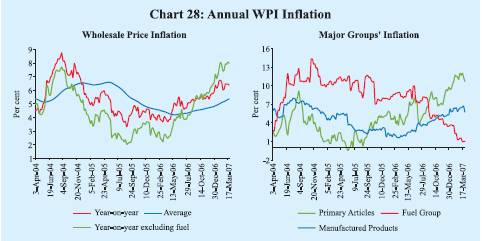
Table 37: Wholesale Price Inflation in India (year-on-year) |
(Per cent) |
Commodity |
|
April 1, 2006 |
March 31, 2007 P |
Weight |
Inflation |
WC |
Inflation |
WC |
1 |
2 |
3 |
4 |
5 |
6 |
|
All Commodities |
100.0 |
4.0 |
100.0 |
5.7 |
100.0 |
1. |
Primary Articles |
22.0 |
4.8 |
25.8 |
10.7 |
40.4 |
|
Food Articles |
15.4 |
5.9 |
22.5 |
8.3 |
22.3 |
|
i. |
Rice |
2.4 |
2.1 |
1.1 |
5.7 |
2.1 |
|
ii. |
Wheat |
1.4 |
12.7 |
4.3 |
7.6 |
1.9 |
|
iii. |
Pulses |
0.6 |
33.3 |
4.5 |
12.0 |
1.4 |
|
iv. |
Vegetables |
1.5 |
7.6 |
2.4 |
1.4 |
0.3 |
|
v. |
Fruits |
1.5 |
-3.9 |
-1.9 |
5.5 |
1.7 |
|
vi. |
Milk |
4.4 |
1.9 |
2.0 |
8.4 |
6.0 |
|
vii. |
Eggs, Meat and Fish |
2.2 |
13.2 |
7.3 |
11.1 |
4.6 |
|
Non-Food Articles |
6.1 |
-2.4 |
-3.5 |
16.6 |
15.5 |
|
i. |
Raw Cotton |
1.4 |
-1.7 |
-0.4 |
21.4 |
3.6 |
|
ii. |
Oilseeds |
2.7 |
-9.2 |
-5.5 |
30.6 |
11.0 |
|
iii. |
Sugarcane |
1.3 |
0.7 |
0.3 |
1.1 |
0.3 |
|
Minerals |
0.5 |
43.6 |
6.9 |
17.0 |
2.6 |
2. |
Fuel, Power, Light and Lubricants |
14.2 |
8.3 |
45.5 |
1.0 |
4.1 |
|
i. |
Mineral Oils |
7.0 |
12.0 |
37.2 |
0.5 |
1.2 |
|
ii. |
Electricity |
5.5 |
4.5 |
8.3 |
2.3 |
2.9 |
|
iii. |
Coal Mining |
1.8 |
0.0 |
0.0 |
0.0 |
0.0 |
3. |
Manufactured Products |
63.8 |
1.9 |
27.7 |
5.8 |
55.9 |
|
i. |
Food Products |
11.5 |
1.0 |
2.6 |
6.4 |
11.3 |
|
|
of which: Sugar |
3.6 |
6.2 |
4.7 |
-12.7 |
-6.9 |
|
|
Edible Oils |
2.8 |
-3.3 |
-1.8 |
14.7 |
5.1 |
|
ii. |
Cotton Textiles |
4.2 |
2.3 |
2.1 |
-1.0 |
-0.6 |
|
iii. |
Man Made Fibres |
4.4 |
-3.9 |
-2.1 |
3.7 |
1.3 |
|
iv. |
Chemicals and Chemical Products |
11.9 |
3.3 |
9.7 |
2.9 |
5.8 |
|
|
of which : Fertilisers |
3.7 |
0.2 |
0.1 |
1.8 |
1.0 |
|
v. |
Basic Metals, Alloys and Metal Products |
8.3 |
-0.6 |
-1.5 |
11.0 |
17.6 |
|
|
of which: Iron and Steel |
3.6 |
-4.2 |
-5.1 |
7.5 |
5.8 |
|
vi. |
Non-Metallic Mineral Products |
2.5 |
9.6 |
5.4 |
9.0 |
3.7 |
|
|
of which: Cement |
1.7 |
14.9 |
5.6 |
11.6 |
3.3 |
|
vii. |
Machinery and Machine Tools |
8.4 |
3.2 |
5.2 |
8.0 |
8.8 |
|
|
of which: Electrical Machinery |
5.0 |
4.1 |
3.1 |
12.8 |
6.9 |
|
viii. |
Transport Equipment and Parts |
4.3 |
0.9 |
0.8 |
2.1 |
1.2 |
|
Memo: |
|
|
|
|
|
|
Food Items (Composite) |
26.9 |
3.9 |
25.1 |
7.5 |
33.6 |
|
WPI Excluding Food |
73.1 |
4.0 |
74.9 |
5.1 |
66.4 |
|
WPI Excluding Fuel |
85.8 |
2.8 |
54.5 |
7.1 |
95.9 |
P: Provisional. WC: Weighted Contribution. |
reflecting stagnant domestic production as well as higher demand. Milk prices increased by 8.4 per cent. Prices of oilseeds witnessed a sharp turnaround - an increase of 30.6 per cent, y-o-y, as against a decline of 9.2 per cent a year ago -which could be attributed to lower domestic production as well as firm global prices. Raw cotton prices increased sharply in March 2007 and prices were 21.4 per cent higher, y-o-y, as on March 31, 2007. Overall, prices of primary articles, 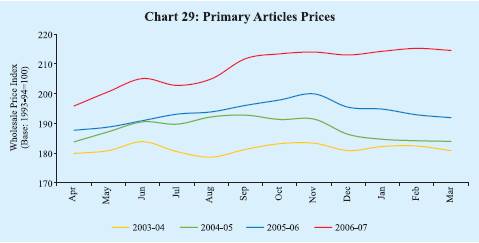
on a y-o-y basis, increased by 10.7 per cent (4.8 per cent a year ago). Primary articles inflation during 2006-07 was the highest in the past decade (Table 38).
In order to contain the price rise in primary commodities, the Government undertook a number of fiscal and supply measures such as (i) allowing the State Trading Corporation (STC) to tender overseas for 55 lakh tonnes of wheat to supplement domestic availability; (ii) permitting private traders to import wheat initially at 5 per cent duty from June 27, 2006 and subsequently at zero duty from September 9, 2006; (iii) allowing import of pulses at zero duty from June
8, 2006 and a ban on their exports from June 27, 2006; (iv) exempting sugar from customs duty from June 22, 2006 and a ban on its exports; (v) allowing imports of maize at zero duty in February 2007; (vi) reduction in customs duty
Table 38: Major Group’s WPI Inflation (year-on-year) |
(Per cent) |
Year |
All Commodities |
Primary Articles |
Fuel Group |
Manufactured Products |
1 |
2 |
3 |
4 |
5 |
1995-96 |
4.4 |
3.1 |
5.1 |
4.7 |
1996-97 |
5.4 |
9.2 |
13.3 |
2.4 |
1997-98 |
4.5 |
4.6 |
13.7 |
2.3 |
1998-99 |
5.3 |
7.6 |
3.2 |
4.9 |
1999-00 |
6.5 |
4.0 |
26.7 |
2.4 |
2000-01 |
4.9 |
-0.4 |
15.0 |
3.8 |
2001-02 |
1.6 |
3.9 |
3.9 |
0.0 |
2002-03 |
6.5 |
6.1 |
10.8 |
5.1 |
2003-04 |
4.6 |
1.6 |
2.5 |
6.7 |
2004-05 |
5.1 |
1.3 |
10.5 |
4.6 |
2005-06 |
4.1 |
5.4 |
8.9 |
1.7 |
2006-07 |
5.7 |
10.7 |
1.0 |
5.8 |
on palm oils by 10 percentage points each in August 2006 and April 2007, and on crude palm oil, sunflower oil and refined sunflower oil by 10 percentage points each in January 2007.
Fuel group inflation moderated to 1.0 per cent on March 31, 2007 from a peak of 9.9 per cent on June 17, 2006 and 8.3 per cent a year ago, reflecting the base effect as well as cuts in prices of petrol, diesel and other fuel products. Following the reduction in international crude oil prices, domestic prices of petrol and diesel were reduced by Rs. 2 per litre (around 4 per cent) and Re. 1 per litre (around 3 per cent), respectively, on November 29, 2006 and, by a similar order again effective February 15, 2007. Earlier, in June 2006, the Government had (i) raised domestic petrol and diesel prices by Rs.4 and Rs.2 per litre, respectively, following the uptrend in international prices; (ii) reduced customs duty on petrol and diesel to 7.5 per cent from 10.0 per cent; and (iii) announced issuance of oil bonds worth Rs.28,000 crore (over and above Rs.11,500 crore issued during 2005-06) to oil marketing companies to compensate for their under-recoveries in domestic operations. The Government issued oil bonds worth Rs. 24,121 crore during 2006-07 in five tranches.
Manufactured products inflation increased to 5.8 per cent as on March 31, 2007 from 1.9 per cent a year ago. Manufactured products inflation during 2006-07 was led by edible oils/oil cakes, metals, cement and electrical machinery. Metals group inflation was 11.0 per cent, y-o-y, as on March 31, 2007 and contributed 18 per cent to headline inflation. Within the metals group, non-ferrous metal prices rose by 29.3 per cent, y-o-y, on top of an increase of 17.5 per cent a year ago, broadly in line with international trends
(Chart 30). Iron and steel prices increased by 7.5 per cent, y-o-y, in contrast to a decline of 4.2 per cent a year ago. 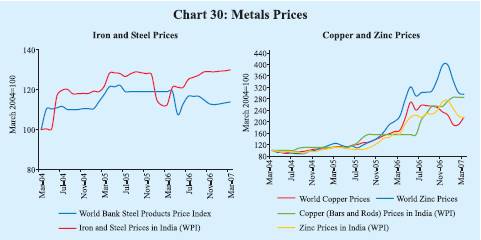
Domestic prices of cement increased by 11.6 per cent, y-o-y, as on March 31, 2007 on top of an increase of 14.9 per cent a year ago, in consonance with strong domestic demand emanating from construction activity. Real GDP originating from construction recorded double digit growth - averaging over 12 per cent per annum - between 2003-04 and 2005-06 on the back of strong housing and other infrastructure activities. Construction activity remained robust during 2006-07, notwithstanding some deceleration (9.7 per cent during April-December 2006). Capacity utilisation in the cement industry remains high (94 per cent during 2006-07 as compared with 90 per cent a year ago). Other manufactured items contributing to higher y-o-y inflation included electrical machinery (an increase of 12.8 per cent, y-o-y, as compared with an increase of 4.1 per cent a year ago) reflecting the higher input prices as well as strong investment demand.
Rise in prices of edible oils (increase of 14.7 per cent in contrast to a decline of 3.3 per cent a year ago), oil cakes (increase of 31.0 per cent as against a decline of 8.2 per cent), and grain mill products (increase of 21.4 per cent on top of an increase of 13.5 per cent a year ago) also contributed to manufactured products inflation (Chart 31). Edible oils and oil cakes along with oilseeds accounted for more than one-fifth of headline inflation. Domestic sugar prices declined by 12.7 per cent (as against an increase of 6.2 per cent a year ago) in line with global trend reflecting higher production.
In order to reduce cost of manufacturing and infrastructure development, the Government took fiscal measures on January 22, 2007 in the form of reduction in customs duties on select items such as inorganic chemicals, non-ferrous metals, cement, capital goods and project imports. The Government further reduced the peak customs duty from 12.5 per cent to 10.0 per cent in the Union Budget 2007-08 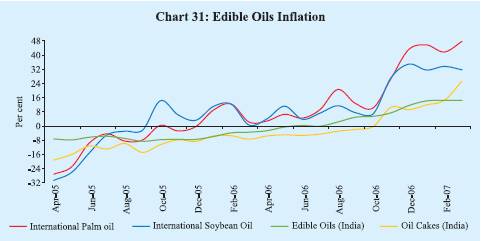
and, in the case of some items, below the peak rate of 10.0 per cent. On April 3, 2007, the Government decided to exempt import of portland cement from countervailing duty and special additional customs duty; it was earlier exempted from basic customs duty in January 2007.
In brief, primary articles' contribution to the overall y-o-y inflation as on March 31, 2007 increased to 40.4 per cent (from 25.8 per cent a year ago) mainly due to higher prices of wheat, pulses, milk, oilseeds and raw cotton (Chart 32). Manufactured products group's contribution also rose to 55.9 per cent (27.7 per cent a year ago) largely on account of increase in prices of edible oils/oil cakes, metals, cement and electrical machinery. The contribution of the fuel group to the y-o-y headline inflation, on the other hand, declined sharply to 4.1 per cent from 45.5 per cent a year ago.
Consumer Price Inflation
Various measures of consumer price inflation remained higher than the WPI inflation during 2006-07, mainly reflecting the higher order of increase in food prices as well as the higher weight of food items in the CPI (Table 39). Food items have a weight of 69 per cent in the CPI for agricultural labourers, 67 per cent in the CPI for rural labourers, 47 per cent in the CPI for urban non-manual employees and 46 per cent in the CPI for industrial workers as compared with 27 per cent (composite) in WPI. Disaggregated data show that food group inflation in various CPI measures rose from 4.9-5.8 per cent in March 2006 to 11.2-11.8 per cent by February 2007. As a result of the higher order of increase in food prices coupled with their large weight in the indices, various measures of CPI inflation increased from 4.9-5.3 per cent in March 2006 to 7.6-9.8 per cent in February 2007. 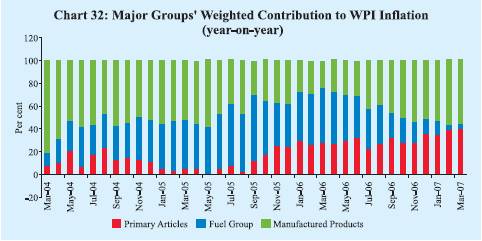
Table 39: Consumer Price Inflation : Major Groups |
(Year-on-year variation in per cent) |
CPI Measure |
Weight |
March
2003 |
March
2004 |
March
2005 |
March
2006 |
June
2006 |
September
2006 |
December
2006 |
February
2007 |
1 |
2 |
3 |
4 |
5 |
6 |
7 |
8 |
9 |
10 |
CPI-IW (Base: 2001=100) |
General |
100.0 |
4.1 |
3.5 |
4.2 |
4.9 |
7.7 |
6.8 |
6.9 |
7.6 |
Food, Beverages etc. |
46.2 |
3.7 |
3.1 |
1.6 |
4.9 |
10.0 |
8.9 |
9.6 |
– |
Pan, Supari etc. |
2.3 |
1.9 |
4.2 |
2.1 |
3.1 |
3.7 |
4.2 |
4.3 |
– |
Fuel and Light |
6.4 |
6.3 |
6.5 |
4.9 |
-2.9 |
8.7 |
6.5 |
5.9 |
– |
Housing |
15.3 |
5.4 |
3.9 |
20.4 |
6.6 |
6.6 |
7.1 |
7.1 |
– |
Clothing, Bedding etc. |
6.6 |
1.5 |
2.1 |
2.3 |
3.0 |
2.8 |
2.5 |
4.0 |
– |
Miscellaneous |
23.3 |
5.3 |
3.2 |
3.9 |
4.6 |
4.7 |
5.4 |
4.1 |
– |
CPI-UNME (Base: 1984-85=100) |
General |
100.0 |
3.8 |
3.4 |
4.0 |
5.0 |
6.5 |
6.6 |
6.9 |
7.8 |
Food, Beverages etc. |
47.1 |
2.6 |
3.0 |
2.2 |
5.3 |
8.9 |
8.4 |
9.2 |
11.2 |
Fuel and Light |
5.5 |
3.1 |
3.2 |
9.6 |
1.9 |
3.0 |
4.2 |
5.9 |
5.6 |
Housing |
16.4 |
6.3 |
5.2 |
7.5 |
5.5 |
5.5 |
5.5 |
5.5 |
5.8 |
Clothing, Bedding etc. |
7.0 |
2.6 |
2.6 |
2.0 |
2.9 |
2.7 |
3.4 |
3.8 |
3.6 |
Miscellaneous |
24.0 |
6.0 |
2.8 |
4.4 |
5.1 |
6.1 |
6.5 |
4.6 |
4.6 |
CPI-AL (Base: 1986-87=100) |
General |
100.0 |
4.9 |
2.5 |
2.4 |
5.3 |
7.2 |
7.3 |
8.9 |
9.8 |
Food, Beverages etc. |
69.2 |
6.0 |
1.6 |
2.2 |
5.5 |
8.3 |
8.0 |
9.9 |
11.8 |
Pan, Supari etc. |
3.8 |
3.5 |
4.7 |
-1.3 |
6.6 |
5.8 |
6.5 |
7.2 |
6.2 |
Fuel and Light |
8.4 |
4.8 |
3.0 |
3.0 |
4.3 |
6.4 |
7.8 |
7.3 |
6.6 |
Clothing, Bedding etc. |
7.0 |
3.0 |
4.1 |
2.5 |
2.2 |
2.5 |
3.3 |
3.3 |
3.2 |
Miscellaneous |
11.7 |
3.1 |
2.7 |
5.5 |
5.5 |
5.2 |
7.0 |
7.4 |
6.8 |
CPI-RL (Base: 1986-87=100) |
General |
100.0 |
4.8 |
2.5 |
2.4 |
5.3 |
7.2 |
7.0 |
8.3 |
9.5 |
Food, Beverages etc. |
66.8 |
5.6 |
1.9 |
1.9 |
5.8 |
8.3 |
8.0 |
9.6 |
11.5 |
Pan, Supari etc. |
3.7 |
3.5 |
4.7 |
-1.0 |
6.3 |
5.8 |
6.3 |
7.4 |
6.0 |
Fuel and Light |
7.9 |
4.8 |
3.0 |
2.9 |
4.0 |
6.1 |
7.2 |
7.3 |
6.3 |
Clothing, Bedding etc. |
9.8 |
3.3 |
3.4 |
2.8 |
2.7 |
2.9 |
3.5 |
2.9 |
2.9 |
Miscellaneous |
11.9 |
3.1 |
3.0 |
5.5 |
5.2 |
4.9 |
6.4 |
7.2 |
6.3 |
Memo: |
|
|
|
|
|
|
|
|
|
WPI Inflation (End of period) |
|
6.5 |
4.6 |
5.1 |
4.1 |
4.8 |
5.4 |
5.9 |
6.1 |
GDP Deflator |
|
3.9 |
3.7 |
4.2 |
4.4 |
4.3 |
4.4 |
5.0 |
– |
IW : Industrial Workers
UNME : Urban Non-Manual Employees
AL : Agricultural Labourers
RL : Rural Labourers |
Higher fuel group prices also contributed to CPI inflation. Prices of services proxied by "miscellaneous group" exhibited a mixed trend, recording acceleration in February 2007 (as compared to March 2006) in the case of CPI-AL and CPI-RL and deceleration in the case of CPI-UNME. Housing inflation (reflecting rents on housing) rose to 7.1 per cent in January 2007 from 6.6 per cent in March 2006 in CPI-IW and to 5.8 per cent in February 2007 from 5.5 per cent in March 2006 in CPI-UNME. Asset Prices
Domestic equity and bullion markets recorded gains during 2006-07, with intermittent corrections during the course of the year. Domestic equity prices fell during May and early June 2006 in line with international equity markets on concerns that monetary tightening might slow prospects for global growth. Equity prices recovered thereafter and the BSE Sensex touched a peak of 14652 on February 8, 2007 before witnessing some correction thereafter (see Chapter V). Overall, the BSE Sensex gained 15.9 per cent during 2006-07 (Chart 33). Domestic gold prices increased by about 10 per cent during 2006-07, broadly mirroring movements in international prices. International gold prices initially rose to US $ 715 per ounce on May 12, 2006 but fell to US $ 559 as on June 14, 2006 in consonance with the trends in various commodities in the international market. Gold prices recovered to US $ 664 per ounce as on July 14, 2006 but again eased to below US $ 600 per ounce in the second week of September 2006 as headline inflation in major economies eased in tandem with softening of international crude oil prices. Gold prices rebounded in the fourth quarter of 2006 and gained further during January-February 2007 to US $ 687 per ounce in late February 2007. Prices softened to around US $ 660 per ounce by end-March 2007. 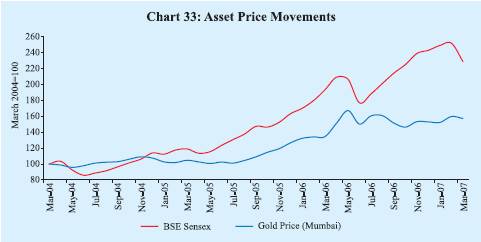
|




































